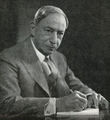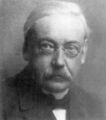Template:Selected anniversaries/August 16: Difference between revisions
No edit summary |
No edit summary |
||
| Line 72: | Line 72: | ||
||1942: World War II: The two-person crew of the U.S. naval blimp L-8 disappears without a trace on a routine anti-submarine patrol over the Pacific Ocean. The blimp drifts without her crew and crash-lands in Daly City, California. | ||1942: World War II: The two-person crew of the U.S. naval blimp L-8 disappears without a trace on a routine anti-submarine patrol over the Pacific Ocean. The blimp drifts without her crew and crash-lands in Daly City, California. | ||
||1957: Irving Langmuir dies ... chemist and physicist, Nobel Prize laureate. | ||1957: Irving Langmuir dies ... chemist and physicist, Nobel Prize laureate. Pic. | ||
||1960, Captain Joseph W. Kittinger made the longest delayed parachute jump on record when he bailed out of a balloon at 102,800 feet. He dropped 84,700 feet (31,330 m) or 16.04 miles (31.3 km), falling for 4 min 49 sec, before opening his main 28-foot parachute over New Mexico. Before opening his main parachute, his near free-fall was stabilized with a six-foot canopy to prevent a fatal flat spin. During the near free fall, he may have broken the sound barrier, reaching 714 mph (1149 kph) in the rarified air at high altitude. He wore a pressure suit. Layers of clothes gave protection in the sub-zero temperatures. He had proved man could survive a fall in near-space. | ||1960, Captain Joseph W. Kittinger made the longest delayed parachute jump on record when he bailed out of a balloon at 102,800 feet. He dropped 84,700 feet (31,330 m) or 16.04 miles (31.3 km), falling for 4 min 49 sec, before opening his main 28-foot parachute over New Mexico. Before opening his main parachute, his near free-fall was stabilized with a six-foot canopy to prevent a fatal flat spin. During the near free fall, he may have broken the sound barrier, reaching 714 mph (1149 kph) in the rarified air at high altitude. He wore a pressure suit. Layers of clothes gave protection in the sub-zero temperatures. He had proved man could survive a fall in near-space. | ||
Revision as of 17:55, 31 January 2019
1650: Monk, cosmographer, and cartographer Vincenzo Coronelli born. He will gain fame for his atlases and globes; some of the globes will be very large and highly detailed.
1694: Mathematician, astronomer, and crime-fighter Christiaan Huygens reveals in autobiography that he uses statistical analysis and games of chance to catch math criminals in the act.
1705: Mathematician Jacob Bernoulli dies. He discovered the fundamental mathematical constant e, and made important contributions to the field of probability.
1821: Mathematician and academic Arthur Cayley born. He will be the first to define the concept of a group in the modern way, as a set with a binary operation satisfying certain laws.
1883: The Orcagna scrying engine predicts that "the Father of Science Fiction will be born within a year."
1884: Inventor, writer, editor, and publisher Hugo Gernsback born. He will publish the first science fiction magazine, and have a profound influence on the development of science fiction.
1898: Mathematician and crime fighter Erik Ivar Fredholm publishes new class of integral equations which anticipate the use of Hilbert spaces in high-energy literature.
1899: Chemist and academic Robert Bunsen dies. He investigated emission spectra of heated elements, and discovered caesium (in 1860) and rubidium (in 1861) with the physicist Gustav Kirchhoff.
2010: Mathematician, academic, and rabbi Eliezer 'Leon' Ehrenpreis dies. He proved the Malgrange–Ehrenpreis theorem, the fundamental theorem about differential operators with constant coefficients.
2016: Signed first edition of Triumph purchased for an undisclosed amount by "a couple, both retired APTO engineers, living in New Minneapolis, Canada."
2017: The upcoming observation of the GW170817 gravitational wave signal, a significant breakthrough for multi-messenger astronomy, is allegedly hijacked before it can occur by a criminal transdimensional corporation. An emergency response team of police astronomers and high-energy physicists will locate the corporation and reverse the hijacking, causing the wave and its observation to occur on time.










